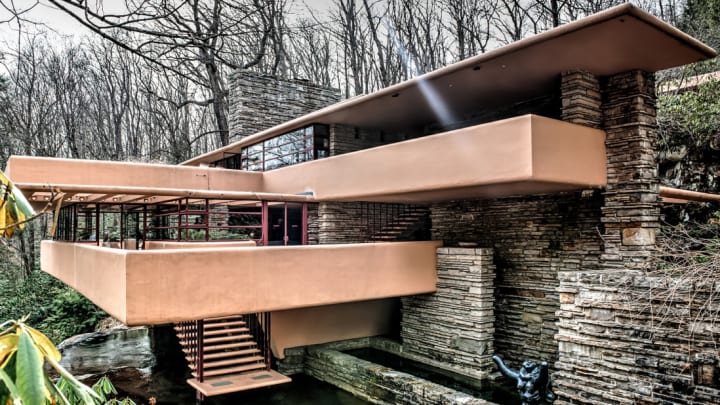We here at Mental Floss are known for lusting after Frank Lloyd Wright’s designs. We’d kill to buy a Wright house in Michigan or Minnesota, on a private island, by a waterfall, or anywhere else for that matter. Even if it wasn’t personally designed by the celebrated architect, really.
But we have wondered why so many houses designed by Frank Lloyd Wright—arguably the most famous American architect in history—are up for sale, sometimes for cheap. (One of his houses in Michigan went on the market for less than $500,000 in 2016.) As it turns out, his houses are really quite hard to sell, as we learned from The New York Times. Here are some of the reasons why:
1. YOU GET A LOT OF GAWKERS.
If you’re the owner of a Frank Lloyd Wright house or the broker trying to sell it, you’ve got to sift through a lot of different visitors, not all of whom are serious about buying. For instance, a bevy of conference attendees at the annual meeting of the Frank Lloyd Wright Building Conservancy in New York City this year are expected to trek out to Wright’s Tirranna, a house in Connecticut currently on the market for $7.2 million, to take a look around. (It’s the one with the waterfall.) Not a lot of those aficionados are going to have millions to spend on a historic house—although some super-enthusiastic Wright fans might.
While the broker selling Tirranna is fine with welcoming the sightseers, not all are so patient. When selling the Cooke House in Virginia Beach in 2016, the realtor only gave tours to prospective buyers that could prove they had the funds available to buy the house, which ended up selling for $2.2 million.
2. NOT EVERYONE WANTS TO PAY TOP DOLLAR FOR AN OLD-FASHIONED HOUSE.
Wright’s creations were thoughtfully designed for their occupants’ comfort, but in some respects, his work can feel dated to people looking to spend big bucks on a house. Real estate professionals, according to the Times, have “to develop a convincing argument for why someone should pay a premium to live in a house with small bedrooms and a snug kitchen, cinder-block walls, cement floors, narrow doorways, a carport instead of a garage and, quite likely, no air-conditioning.” Currently fashionable features like open kitchens and numerous bathrooms don’t exist in mid-century homes like Wright’s.
3. THEY’RE OFTEN IN FAR-FLUNG PLACES.
Wright’s studio in Wisconsin designed houses that were built all over the country. Given how cities have grown since the 1950s, fewer people are looking to live on giant estates in hamlets like Galesburg, Michigan (population: 2000)—site of the $500,000 Wright house—or Willoughby Hills, Ohio (population: 9500). While people might be ready to pay top dollar for an L.A. landmark, even the most dedicated architecture buffs might not be willing or able to relocate to the rural Midwest just for a great house.
4. OWNING A WRIGHT HOUSE MEANS DEALING WITH WRIGHT FANS.
Strangers don’t typically feel like they have a stake in your suburban tract home, but Wright has some pretty dedicated fans. And they have things to say about the way you’re handling your house. “It’s like dealing with a group of theater critics,” one Wright home owner who’s looking to sell told the Times. “You’ve got to put on a good performance to generate accolades, and if you don’t, you’re going to hear from them.”
5. YOU PROBABLY DON’T WANT TO SELL TO JUST ANYONE.
When you live in a piece of architectural history, you become a sort of steward of that history. So when it comes time to move on, you don’t want to hand it off to someone who won’t take care of it. Clients hoping to sell their Wright houses can be particularly vigilant about vetting prospective buyers. “It was no different than if he had a daughter, and the buyer wanted to take her hand in marriage,” one broker said of the client whose Wright home she sold in 2016.
Despite the challenges of living in, and eventually selling, a house by an architect as famous as Wright, for many people, the costs—financial and otherwise—are worth it. As one owner put it, “Would you believe it if somebody told you that someday you’d own a Rembrandt?” The only difference here is that Wright’s designs are art you can live in. Seems like a lot of pressure to keep the kitchen clean, honestly.
[h/t The New York Times]
